
Chapter Two: The Mighty Siang
A kayaking Expedition to the Far East: Planes, trains, and automobiles to
the most Remote corner of India.
By Rafa Ortiz and Ben Stookesberry
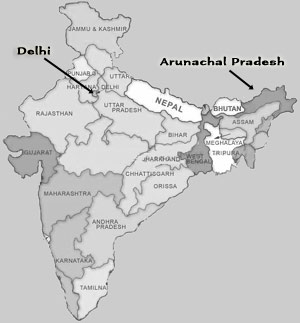

Chapter Two: The Mighty Siang
A kayaking Expedition to the Far East: Planes, trains, and automobiles to
By Rafa Ortiz and Ben Stookesberry |

|
|
We had just finished the Kameng River, which was an amazing hundred mile journey with lots of great whitewater. After so many long days of paddling, we were in need of a rest. However, we were eager to reach to the Siang, which was the one we had been waiting for. So, we immediately began the next leg of our journey.
The plan was to skip the next major drainage east en route to the principal tributary of the Brahmaputra: the distal end of the Tsang Po, referred to locally as the Siang River. Roland quickly tempered our excitement by commenting that the veritable Tijuana circus of our previous shuttle was nothing compared to the three and a half days of jeeping ahead of us. We left the border town of Balukpong the next morning with some of Arunachal's finest guides from Donya Hango Tourism, renowned photographer Lucas Gilman, and his girlfriend / assistant Sarah Randazzo. Two flat tires and seven bone-jarring hours later we sidetracked slightly to Arunachal’s capital city of Itanagar. Although we could have saved some time by staying on the main road east through Assam, Itanagar would be our last chance for two weeks to check email and enjoy a few other modern conveniences. Besides email, a civilized morning in the 'big city' brought buckets of hot water for our first proper showers in a week, and local barbers offered a one-of-a-kind south asian shave. Leaving Itanagar, the road made a quick and pleasantly smooth descent out of mountains, re-entering the flat yet rugged roads of Assam. After many days on the river, we resigned ourselves to another fine evening of "Jeep till you puke." Travel is difficult in Assam because the roads are absolutely ruined. Monsoon flooding and separatist bombings both contribute to ruts, potholes, and craters that few road crews are brave enough to fix. On top of that, the road is bursting with a riotous mix of drunken pedestrians, shaky bicyclists, massive ( yet extremely slow moving ) trucks, and hour-long single lane detours.
|
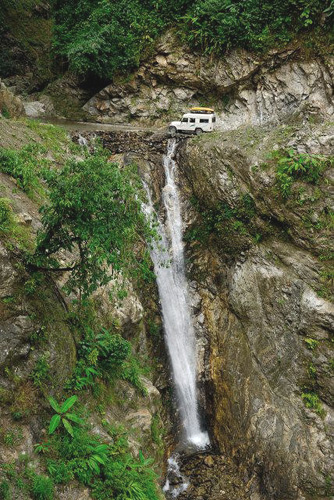
|
A village in the clouds en route to the Siang.
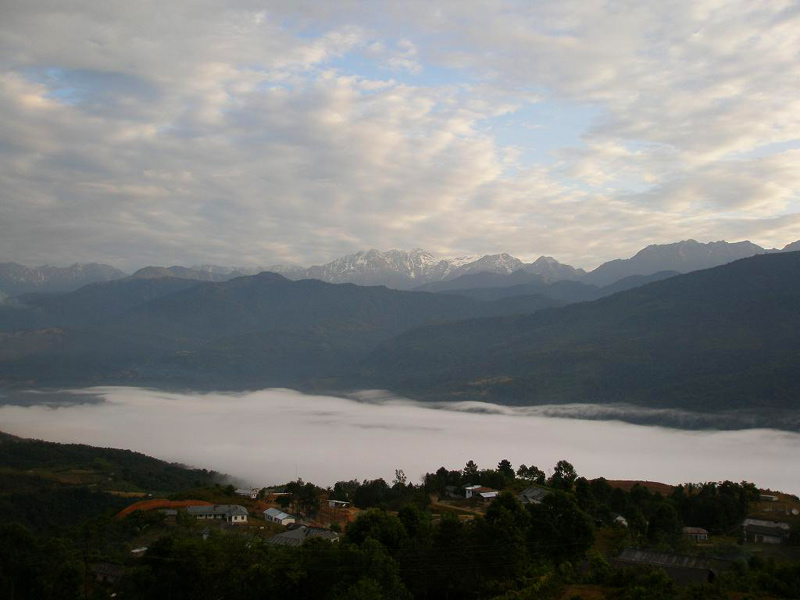
The journey was tiring and painful. After one more flat tire and another seven hours of driving, we stumbled out of our jeep into brilliant moonlight at the Donya Hango camp in Pasighat.
I had been craving a nice home-cooked Mexican chicken mole or some tacos, but instead we were blessed with another delicious Indian feast. This time we were treated to fresh fish from the Brahmaputra smoked in banana leaves, accompanied by the usual rice, lentil dal, and cabbage-potato subji.
Aside from the fresh fish, this meal was taken to the next level by the world’s hottest chile, a native of the Brahmaputra valley. After several nice glasses of homemade rice beer and a little of that special rum, a hilarious episode ensued where Ben, Vipin, and myself dueled with the atomic chiles ( which of course left us doubled over in agony on the lawn ). As the pain of the chiles faded away, I found that I had forgotten about the days of jeeping still ahead.
Our hosts, hard at work in the kitchen..

From Pasighat we headed north towards the border with China. The road became smaller and sketchier, and the terrain steeper. The jungle also thickened considerably, and the landscape became more beautiful and imposing.
We caught our first glimpse of the Siang later that day. We were traveling along a small road etched into the near vertical canyon wall when we came to a clearing overlooking a valley. The Siang was a monster, making the Kameng look like a small creek in comparison. It is impossible to say for sure, but we estimated that there was about 40,000 to 50,000 cfs of milky, glacial blue water in the riverbed.
Our first glimpse of the mighty Siang.
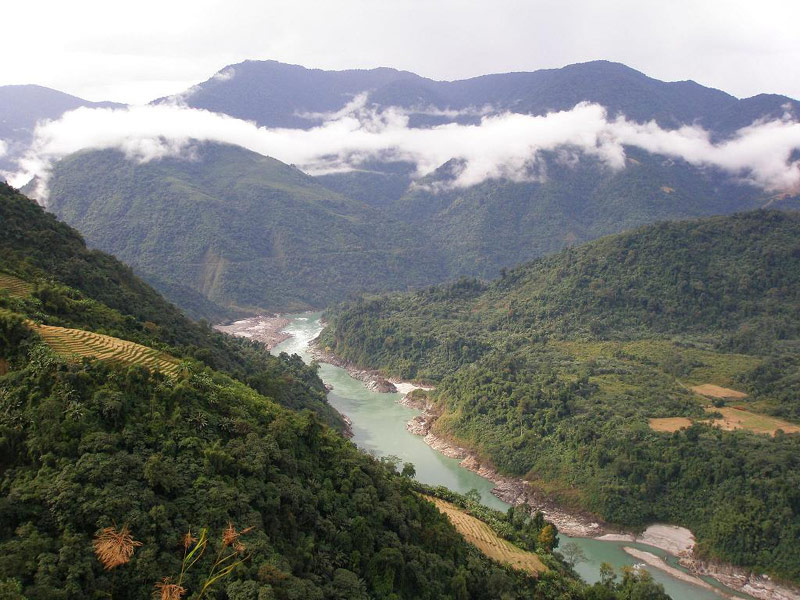
It took two more full days to arrive in Tuting, which was still thirty kilometers short of our planned put-in.
We owed our extremely slow progress not only to the convoluted road, but also to the now typical Indian driving adventures. On top of the usual flat tire or two a day and other full on jeep-related difficulties, the shipments of diesel up the Siang had been delayed for weeks, which meant we didn't have enough fuel to reach our destination.
Luckily, the Donya Hango boys found some diesel, but it was on the wrong side of the river. We spent the next three hours shlepping jerry cans of fuel back and forth across a two kilometer long bamboo suspension bridge before we had enough to continue our journey.
When I say that the four days of abusive shuttling were worth it, you start to get an idea of the uniqueness and magnificence of this river. With an immense flow and clean turquoise water in the dry season, the Siang is a river like no other.
The Siang is known as the Tsang Po in China, and is infamous there. However, once the Tsang reaches India and becomes the Siang, it is unknown. Well, after our trip I am confident that the Siang is destined to become the world’s next big water classic.
For those who know, the whitewater is on par with the Grand Canyon of the Colorado with some bigger drops, white sand beaches, and spectacular Himalayan views. An epic, but reasonable two hundred and fifty mile section just waiting for whitewater adventurers from around the world!

|
From Tuting upstream to the border with China, the river is all but unknown to the western world. However, some locals reported that they had seen the first group of Indian kayakers on the stretch only a month earlier. After a short drive upstream through a chilly, foggy morning rain, the road ended abruptly at the town of Bona.
This is where our hike began. First we had to endure the most uncomfortable sensation of donning cold, wet gear; ours had been soaked from the unexpected overnight rain. We completed this task quickly and shouldered our boats, eager to get on the river as soon as possible. For the next two hours we hiked along the trail which straddles the border region between Arunachal and China. The trail itself was lined with military bunkers, and throughout the hike we had to cede the trail to AK-toting soldiers marching in both directions. The troops presented us with only smiles and greetings, not giving us any troubles or queries about the extent of our permit ( we were actually only permitted to put in as high as Tuting, but we decided to try our luck by hiking upstream ). It was pretty clear that the area we were in was a potential conflict zone between two nations. For now, it was our way to the river. Just before the hilltop village of Geling, we started hiking down to the water on a steep, muddy trail that had been hacked through the jungle to provide access to the river. After half an hour, our overheated systems were rewarded with perfectly cold, clean water of what is called the Tsang Po on the China side and the Siang on the India side. After a bit of lounging and speculating what whitewater monsters waited in both directions, we entered the Siang higher up than any westerners before us. |
The first of many white, sandy beaches on the Siang.
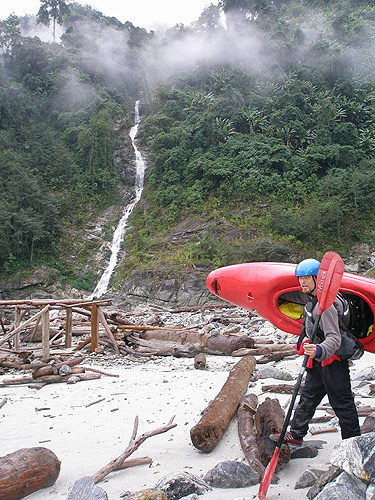
|
Amazing scenery at river level on the Siang.
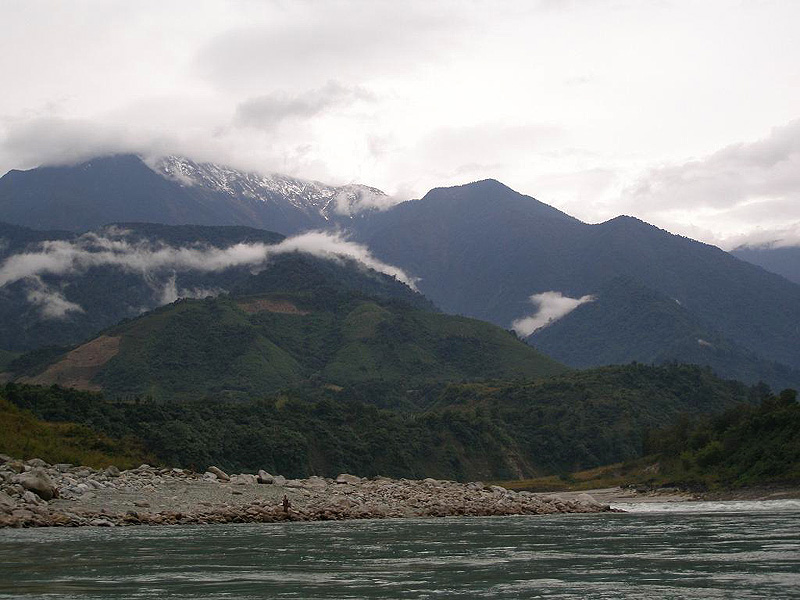
Entering the current we quickly became aware of the size and power of this river. We paddled into a seemingly class two wave train and were forced to ferry hard as the river slammed into a vertical canyon wall just downstream. We felt very small in the middle of this vast, rolling ocean of a river.
The power of the Siang was on a scale I have rarely experienced and the shore was at least half a kilometer in either direction. "This is the biggest river that I have ever paddled!" I yelled, and Ben agreed with a deer-in-the-headlights look on his face.
This was the biggest river either of us had ever paddled.. The features were massive.
Rafa skirts a typical Himalayan-sized hole.
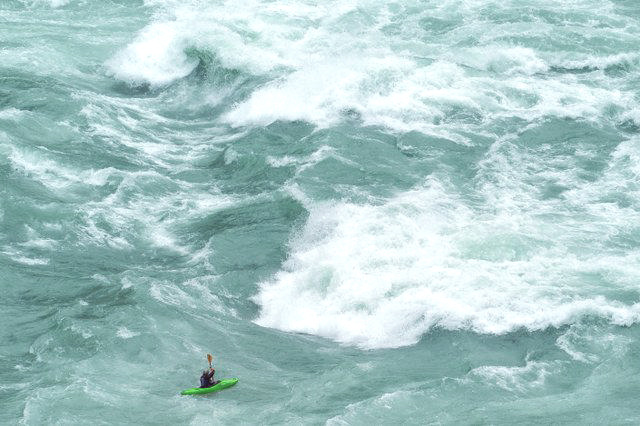
The top of the next rapid was a horizon line and boat scouting here would have been an act of pure faith; therefore, we scouted from land. It would have been nice to minimize a veritable overland journey by simply boating to the brink of the drop for a quick look, but the main flow was extremely strong starting at least a hundred meters above the initial wave train.
Luckily, the massive boulders on shore sheltered slower moving water, and we were able to eddy out much closer to the start of the main drop than we anticipated.
I choose an adventurous line on the right and ping-ponged between massive three to five meter laterals and holes. The whole thing then culminated in one of the biggest wave holes I have ever seen. It was surging from a four meter deep nasty looking hole to a six meter green face. On our second trip through, I would plug in there, reemerging twenty feet downstream! After seeing my antics through the ledge infested right side, Ben found the big water super highway down the middle that pulled some of the teeth out of this monster..
Ben rides the big-water super highway down the middle of the Siang..
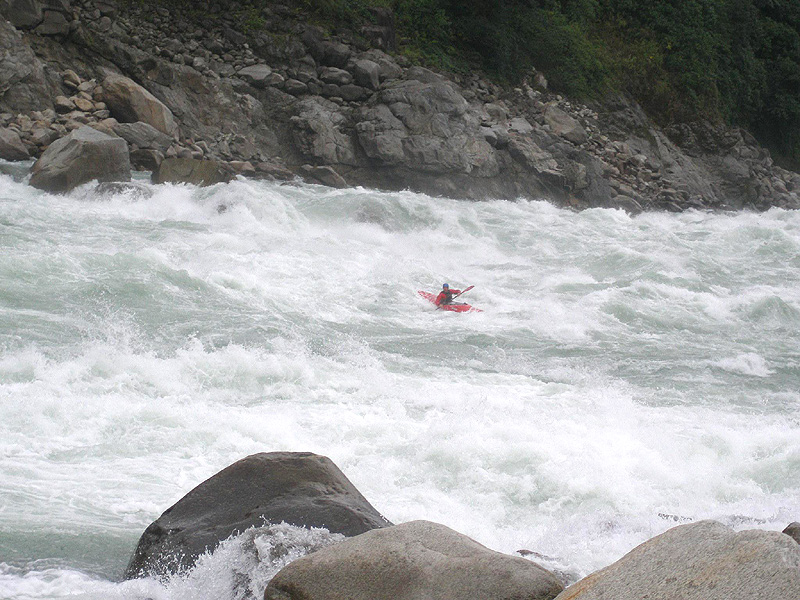

After this huge rapid we gained some confidence, and decided to make a conscious effort not to get mired down bank-scouting every single rapid. When we reached the next horizon line we drifted out into the middle of the river, determined to boat scout this one.
The rapid started as a seemingly innocuous wave train. From the top of the massive standing waves I caught glimpses of the whole river turning left towards a significant horizon line. It looked steep and beefy, but we were now committed, having given up our ability to scout about half a kilometer upstream. Ben was out in front as we passed the first truly gigantic hole, off to the right.
I looked over my shoulder at this hole, which could have cartwheeled a school bus or two. I tore my eyes away from this hydrological horror and refocused downstream only to see Ben charging right with the powerful, fast forward strokes that you save for the most desperate situations.
I started pulling hard after him, but suddenly a big wave formed out of nowhere and broke on my head, whiting me out and flipping me. As I started to roll, I felt myself falling, it was an amazing feeling for a moment or two until the worst pounding of my life began.
I rolled up into my worst nightmare: On my right I saw an angry twenty-foot-tall surging wall of green, and to my left a raging foam pile bigger than my house. I took a desperate gulp of air and clamped down on my paddle with all of my might. After that there wasn't anything I could do but hang on for dear life and hope.. survival was the goal, swimming not an option.
The next minute was like one of those nasty amusement park rides gone dangerously wrong: tricky woo, air screw, woopty doo.. Again and again I was thrown wildly into the air and tossed about like a bit of debris as I desperately tried to protect my skirt and not lose or break my paddle. Finally the bow of my Rocker dug in and I was shoved deep, bouncing crazily off the bottom of the river and emerging some distance downstream, wide-eyed and flushed with adrenaline.
Surfing the biggest hole in the Siang was probably the scariest moment of my paddling career and I took it as a lesson..
Ben fires up another big one on the Siang..
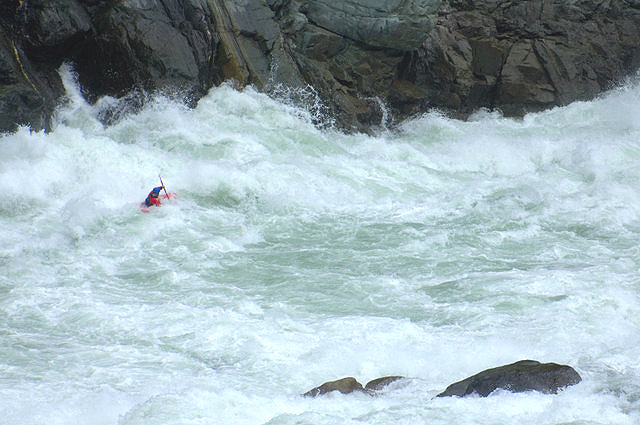
The rest of the run was outrageous with only one more truly scary rapid. Aside from that, this section of the Siang must have some of the biggest wave trains on earth. Ben commented that one in particular dubbed 'Amazing Four' and said it made the rapid known as 'The Himalayas' on Chile’s Futaleufu look like 'The Appalachians..'
|
The land crew followed our progress throughout the run, shooting photos and videos from the road where possible, and also hiking down to river level in a few spots. We spent two consecutive days on this same section of river, but we could have easily spent a week there.
For what we could appreciate from our creek boats, some the waves had incredible potential for playboating. Below Tuting, Roland has plans to run his guide school and commercial trips on the 250-plus mile stretch of the Siang down to Pasighat.
After each day on the river, we consumed three hearty meals to satisfy our roaring bellies. One night Nino, the head of Donya Hango, treated us to a meal of homemade rice and fish at his uncle’s house in Tuting. The fish was straight from the Siang, and the rice was direct from his fields high above the river. Sharing amazing food and stories around a traditional open living room fire was one of the highlights of the trip. We had decided to skip the long bottom section of the Siang in order to have time for our next destination. We were going further east, either to the Dibang or to the Lohit valleys, where legendary class five awaited us. This time we made the return trip to Pasighat in just one day with an absolutely commendable effort by our brilliant shuttle driver NB. NB was the kind of guy that you want along for every expedition: super dependable with a heart of pure gold. We thought we had seen the worst Arunachal could throw at us in terms of the shuttle, but we were wrong. A late monsoon tempest would nearly stop the final leg of the expedition dead in its tracks.. |
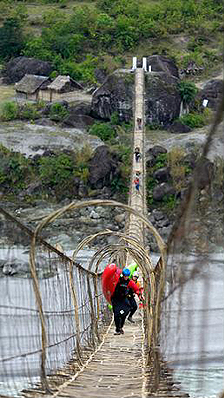 |